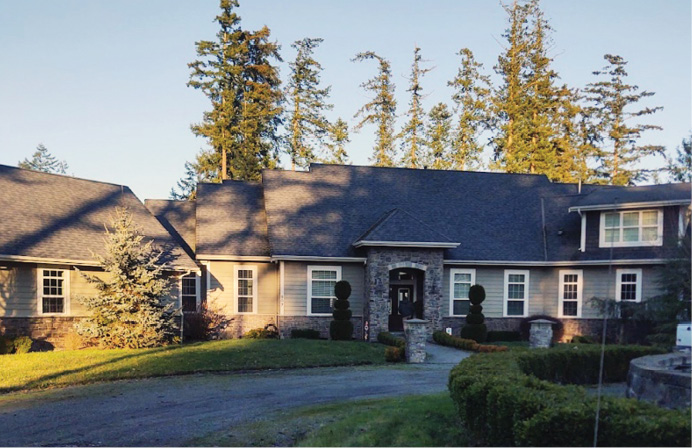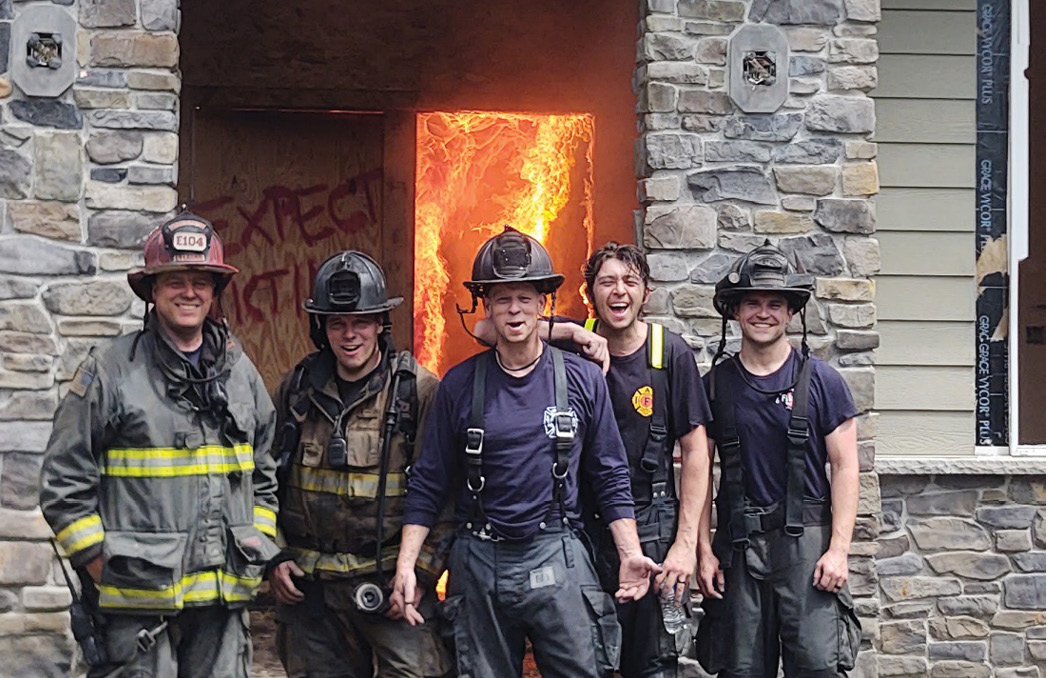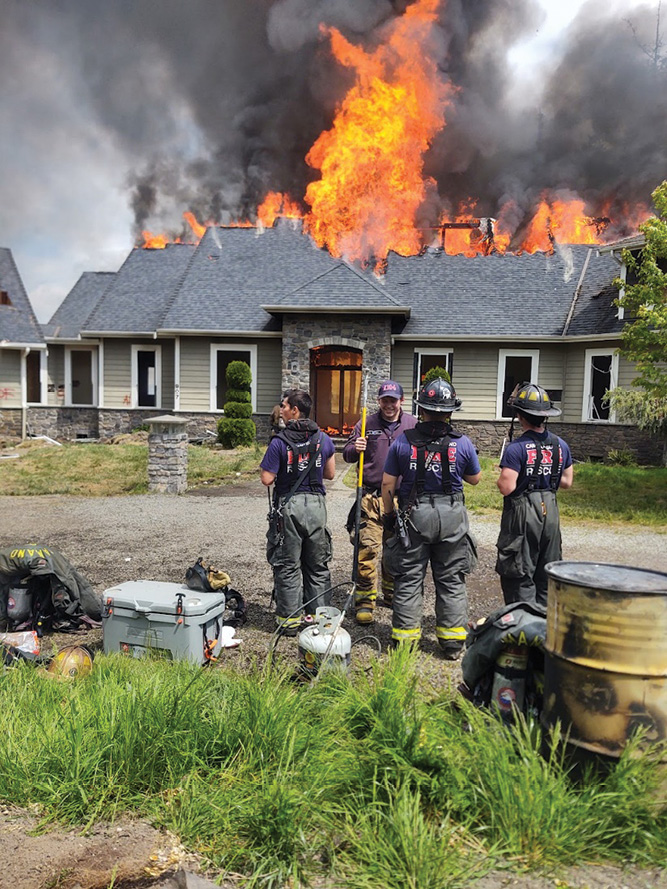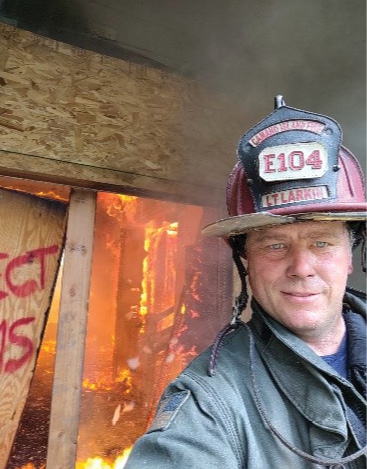BY DANA LARKIN
In February 2021, my fire department heard from an individual who was interested in donating his house for training purposes. The training homes our firefighters had used in the past were generally 30 to 40 years old and small, offering limited value on what firefighting tasks and drills we could perform. They also usually came with unrealistic time constraints, like wanting to start the next day or having all the training done in three to four days. So when I went to do the walk-through, my expectations were low.
- Training in Acquired Structures: A Beginner’s Guide
- Getting the Most Out of Acquired Structure Live Burns
- ACQUIRING STRUCTURES FOR TRAINING
- Fire Training in Acquired Structures
I entered the home on the property and started my conversation with the owners, who were still living there. I looked out the windows and couldn’t see another home on the property. I was sure I was about to be taken out to a 40-year-old single-wide tucked back in the woods. I asked the owners a few questions. Where was the house they wanted to burn located? What was its condition? What was their timeline?
Their response took me by surprise. They told me we were standing in the house they wanted demolished, which was their current residence (photo 1). The 3,500-square-foot, 14-year-old house was pristine and valued at $1.4 million. They told me they were going to need two months to move out, at which point we could have the house for 25 days. I had two months to prepare and plan the training.

1. Photos by author.
Plan for Training
My goal was to get as much value out of the house as possible. (Editor’s note: All acquired structures used for live burns need to be reviewed/prepared consistent with National Fire Protection Association 1403, Standard on Live Fire Training Evolutions.) I came up with a checklist and thought through the pros and cons of each. This list included the following:
- Search.
- Hose deployment (interior and exterior).
- Forcible entry.
- Firefighter survival.
- Vent-enter-isolate-search (V-E-I-S).
- Ventilation.
- Window conversions.
- Water supply.
I decided that the most practical approach would be to focus on the basics and plan the training to correspond with the strategic and tactical direction I wanted the department to go in. As the department’s training officer, I saw this as an opportunity to focus on the drills I thought could make a significant change. We had just made the conversion from high-pressure lines with fog nozzles to low-pressure lines with 7⁄8-inch smooth bore nozzles. I had pushed for that switch and still got some pushback from more than a few members.
I looked at the calendar and how the shifts lined up. I decided to split the training into three groups. Each shift would have one 48-hour rotation per group. Each day would be divided into three-hour blocks. We have three staffed stations, so each station would get a three-hour block of time to do that day’s training. The training would repeat on day two, allowing for further practice and to get any members who had the first day off. We would also change the day-two scenarios to make them a bit more difficult or time sensitive. This would give members who were on both days a bit more of a challenge.
That meant that each shift (A, B, and C) would get four days of training in the house. All the training would be the same for each shift, as I felt it was critical to have consistency across all the shifts. At the end of the rotations, we would have three burn days, one per shift day. With this plan, on the final day—when we burned the house completely to the ground—each shift would have spent four training days in a real home. In the end, I spent 22 straight days at the house, running all the evolutions. It was an amazing experience and really set the tone for what we were doing at our department and how we were changing our mindset when it came to fighting fires (photos 2-6).

2

3

4

5

6
How We Ran Training
From the time when the opportunity first came up until the first crews showed up for their training day, only the assistant chief, one department member who owns a construction company, and I were allowed inside the home. This met a lot of resistance, but it meant that the first evolution every company did was done as a second arriving company assigned to search.
We let the crews see the home, showed them pictures of the house with smoke showing from assorted windows, and assigned them floor-one primary search. Once they were ready and at the front door for entry, we put smoke-out masks on their self-contained breathing apparatus face pieces. This and all scenarios were run in real time, on air, with radio communication. We wanted to be as realistic as possible. Here’s an overview of the schedule we followed.
- Day 1. Search: Size-up, oriented man, blackout, primary, secondary.
- Day 2. Hose: Stretches, upstairs/downstairs, estimates, dry and wet.
- Day 3. Hose: Port-a-tank, horizontal standpipe, defensive, redeployments.
- Day 4. V-E-S and Ventilation: Vertical vent, ladder building, V-E-S second floor.
Day One
When the crews exited the structure, we had them describe the layout of the house. They then went right back in on the second scenario, which was primary search, floor two. Again, on exit the crews were asked to describe the layout of the home. All three shifts were close with their descriptions, but all of them had errors in the layout. After the first two search events, we did a walk-though of the house so they could see how their picture of the home lined up with the actual layout. Next, we had the crews switch up the leads. They went back in with the smoke masks and redid the scenarios. We had a great discussion on oriented man and how to best manage our teams and tools during search.
One second-floor bedroom had a small door, approximately three square feet, which led to a child’s play area. When the crews entered that room, we filmed them searching and then immediately after clearing the room, we showed them the video. All crews missed the small door, and most of them even felt the trim around the door jamb. But through their gloves, they didn’t make the differentiation between the jamb and the chair rail around the room. That showed us that multiple training evolutions year after year at our training prop was teaching bad habits and dulling the senses in terms of what we were looking for. After the first two blacked-out primary search scenarios, we went through secondary search and assessed the major differences between those two events.
Day Two
For the crews, day two was all about hose. The crews were dispatched to a structure fire. When they arrived on scene, we again showed them doctored pictures showing smoke and fire from assorted windows. The officers did a full arrival report and 3600 walk-around while directing their crew. The point was to make it as realistic as possible. We timed each crew from air brake to water showing at the front door and did multiple evolutions, allowing all our officers and acting officers time in the command seat.
The next part of day two was stretching dry and wet hoselines up and down stairs. This might be a common practice for most departments, but our service area has limited opportunities for practicing this valuable skill. This exercise really showed a deficiency in our training program and was a true benefit of our having the use of this home.
We also spent some time having our members estimate the amount of hose they would need from the engine to reach different places in the home and on the property. After noting everyone’s answers, we pulled hose to those areas. For most, this was a great confidence builder. It showed how well they estimated and was a reminder about maintaining this important skill, given our long driveways and set-back homes.
Day Three
The third day served as an additional day of hose deployments but with a focus on some areas that might be unique to our department. We have very few hydrants and rely on water tenders (tankers, for any East Coasters) for water supply. We did some port-a-tank and drafting evolutions to make sure everyone was up to speed on drafting. We also spent quite a bit of time on extended attacks and on coming up with a definition of what that means so everyone could be on the same page. We have many properties with detached garages, mother-in-laws, and side or rear efficiencies that can’t be reached from the front door of the main residence, shops, and second structures located behind the home or farther from the driveway.
We also have many inaccessible driveways that will require hose pulls from the street. Beyond the range of preconnected hoselines, we were all over the place on how the officers and the firefighters defined an extended attack. We used this to come up with a “standard,” or our official play, and started to have everyone think of that standard when an officer called for an extended attack.
Another day-three focus was the communication between the officer and the crew on the redeployment of an initial attack line from A side to C side. Our department operates on an island, and we have many homes that are one story from the A side and two or three stories from the C side. This means that we have many daylight and walkout basements and a high probability of an initial report of an A side fire that is also a C side fire. Redeployments are common, and we didn’t have a standard on how to think through that process. Practicing that scenario on this house was another great opportunity to standardize a play.
Day Four
The first time that we started to destroy some parts of the house was day four. This was only possible due to the design of the house. We did forcible entry, V-E-I-S, and vertical ventilation. One really helpful factor was that everything was intact.
Aside from the front door, we left all the doors and windows in place. The house also had an enclosed breezeway between the kitchen and the garage. This allowed us to take the windows of the breezeway for forcible entry. We were also able to do ventilation on the garage and cut as many holes as we wanted to, because we were able to partition that section off from the rest of the house. We made a window prop for one of the second-story bedrooms and used that window for V-E-I-S. Again, we rotated all three staffed stations through the house in three-hour blocks of time. We were able to ensure that everyone received the same training and suggestions to keep continuity throughout the department.
Burn Days
Finally, we got to the burn days. Each shift had a single eight-hour day for live fire. We made sure to backfill the entire shift so everyone could participate. The house had two floors on the D side and the second floor had three bedrooms. The staircase was just off the main entrance and provided a great situation for having multiple crews working at the same time.
We set up the scenarios so the engine would show up first and then set the timing for the other crews to show up and be assigned by the working command. We prepped the bedrooms by attaching extra plywood to the floors, walls, and ceilings. This allowed for multiple burns in each room. The plan was to burn in a single bedroom each day, which would allow for three full days of burning. We ultimately had to use the larger of the bedrooms near the end of day two. We finished it on day three. We also ended up with the last evolution of the third day being in the first-floor master bedroom. We let that fire get much bigger before sending in crews.
Our department also reached out to a few neighboring departments. Three of them set out an engine company on each live fire day.
A Few Surprises
A few issues surprised us. We encountered one eye-opener during the blind primary search. Having done so many search evolutions in our training prop, we really thought we were proficient at primary search. What we didn’t realize, or at least didn’t want to admit, is that familiarity with the layout had made our focus on situational awareness dip. This caused some confusion when crews needed to describe the home’s layout.
Most of the crews admitted that their primary search was still done in “training mode.” They went too fast, did not pay enough attention to detail, and found notable differences between second and third attempts through the building. We had been allowing training scars to creep in, and it was a valuable lesson.
Different officers had different ways of thinking about how to complete certain tasks and wanted the ability to do things how they saw fit. Every officer wanted to run their “audible” (like running a play in football) based on what was presented to them. That would ultimately create too much confusion when firefighters are working different shifts or doing trades and would make it impossible for the department to teach new firefighters what to expect.
We had a discussion with the officers about establishing standards and teaching everyone the same way. We discussed the idea that while audibles are great, they are, ultimately, variations based on a single play. If you don’t have the play down, it is impossible to make an audible.
Important Takeaways
We now teach extended attack to standard play, and the officer can make an audible based off the situation. But now everyone knows what the expected standard is. And now, when we go over concepts or tasks, we always start with the definition and accepted standard play. Then, we discuss some officers’ preferences, what audibles might be called, and why. It has truly allowed all line staff to get on the same page and have a clearer idea of what to expect.
Watching all the crews for 22 days, I saw a greatness from our officers and firefighters. They performed at high levels that I hadn’t seen them reach before. Some of that was the result of the excitement of being in an actual house instead of a training prop. On the flip side, I saw where we needed more work. It was a good lesson for me on viewing our crews—and skills—more objectively.
Note to Self
I was so focused on getting as much out of the house as possible that I had the crews do too many different tasks. It might have been better to leave out a few of the evolutions and focus more on hose and searches. I also went right up against the homeowner’s timeline. If I had not pushed it to the deadline, I could have allowed for more hose movement and water flow inside the structure.
I had crews pull charged hoselines but didn’t allow for much water flow because I was worried about oversaturating the building and causing water damage to some of the rooms we needed to burn. It might have been better to flow more water and then let the house recover before burn days rather than be in there every single day.
A Win for All
One of the biggest successes was building team camaraderie. Everyone was excited to do the training and to have the opportunity to improve. I also used this experience as an opportunity to start a training committee and bring in a firefighter from each shift to help with the training. This has allowed us to better push training to the shifts and keep a consistent message. It also created an opportunity for some of our newer firefighters to take on leadership roles with their shifts. This has created a new level of mentorship and creativity in our department, and our training events have never been better.
The training and events that happened over those 22 days still come up. People are still talking about it. They want to do it again. The experience created a great foundation for our training division. We are a department with many younger members, and all that practical time in a real building did wonders for everyone’s confidence.
DANA LARKIN is a battalion chief and training officer for Camano Island (WA) Fire and Rescue. He has been with Camano since 2002 as a volunteer, part-time firefighter, and since 2006 a career firefighter. He has a bachelor’s degree in sociology and fire service administration. Larkin is an ISFSI-certified live fire instructor and has conducted live fire training for multiple departments. He’s also the founder and past president of Cascade F.O.O.L.S. and the treasurer of F.O.O.L.S. International. He has been the lead instructor for training all of Camano’s new part-time and full-time firefighters over the past four years.

